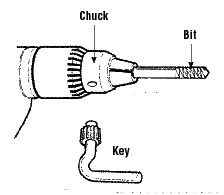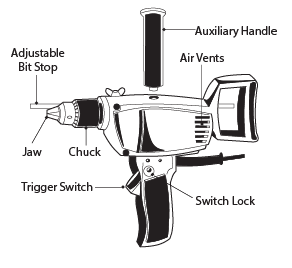Powered Hand Tools - Drills
On this page
How do you select the proper bit or attachment?
Back to top- Follow manufacturers' instructions when selecting and using bits or attachments, especially with unfamiliar drills or work.
- Select bits or attachments that:
- match the size and capacity of the drill.
- are appropriate for the material and the type of work.
- Ensure all bits or attachments:
- are properly seated and tightened in the chuck.
- turn true to avoid vibration or imbalance.
- Use the auxiliary (second) handle for large-scale work or continuous operation.

What should you do when working with powered hand drills?
Back to top- Wear safety glasses or a face shield (with safety glasses or goggles).
- Keep drill air vents clear to maintain adequate ventilation.
- Keep drill bits sharp.
- Inspect for frays or damage before each use.
- Keep all cords clear of the cutting area during use.
- If using a battery-powered drill:
- inspect the battery for any damage, cracks, or leaks before use.
- follow the manufacturer's instructions for charging and storing the battery. Avoid overcharging or exposing it to extreme temperatures. See the OSH Answers on
Battery Charging - Lithium-ion Batteries for more information.
- Disconnect the power supply before changing or adjusting bits or attachments.
- Tighten the chuck securely. Remove the chuck key before starting the drill.
- Secure workpiece being drilled to prevent movement.

- Slow the feed rate just before breaking through the surface to prevent damage.
- Drill a small "pilot hole" before drilling large holes to improve accuracy and to reduce stress on the bit.
What should you do when working with small pieces?
Back to top- Clamp small stock securely to prevent twisting or spinning.
- Never drill with one hand while holding the material with the other.
What should you avoid when working with powered hand drills?
Back to top- Do not use bent drill bits.
- Do not exceed the manufacturer's recommended maximum drilling capacities.
- Do not use a hole saw cutter without a pilot drill.
- Do not use high-speed steel (HSS) bits without cooling or using lubrication.
- Do not attempt to free a jammed bit by starting and stopping the drill. Unplug the drill and then remove the bit from the workpiece.
- Do not reach under or around the stock being drilled.
- Do not overreach. Always keep proper footing and balance.
- Do not raise or lower the drill by its power cord.
- Do not use the drill in wet or muddy locations. Use a nonpowered drill instead.
- Do not use excessive force to drill into hard material. Reduce drill speed if possible.
- Do no use
Refer to Powered Hand Tools - Basic Safety for Electric Tools for general safety tips.
- Fact sheet last revised: 2025-04-30

